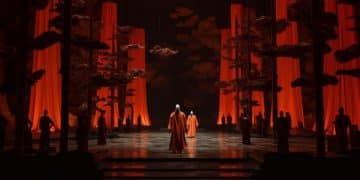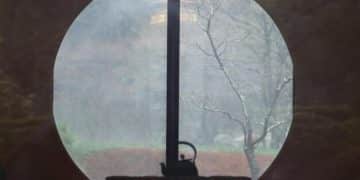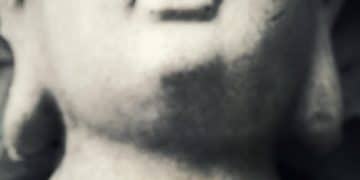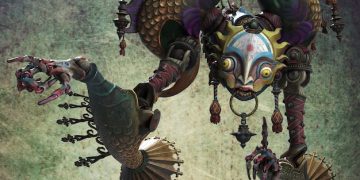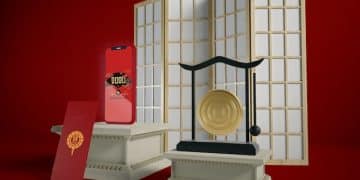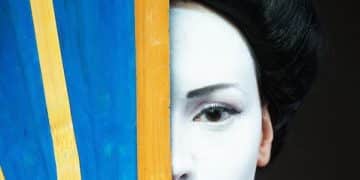Chinese Drama Historical Accuracy: Fact vs. Fiction
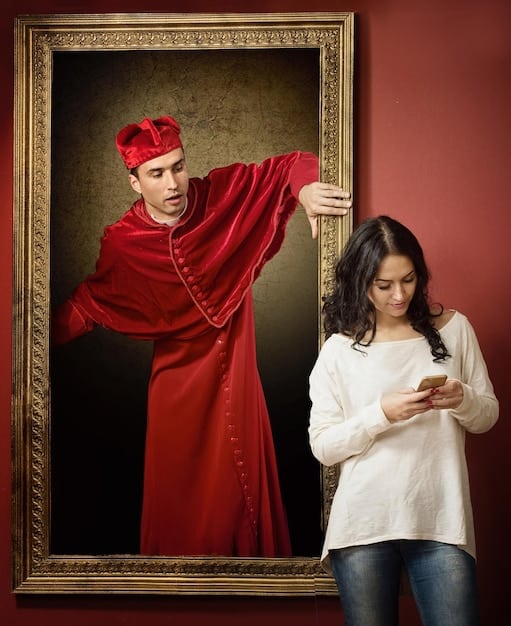
Advertisements
Chinese drama historical accuracy is often debated, as period dramas blend historical events with creative license, resulting in varying degrees of adherence to actual history, requiring viewers to distinguish fact from fiction.
Chinese period dramas captivate audiences with their elaborate costumes, intricate plots, and glimpses into bygone eras. But how much of what we see on screen reflects the Chinese drama historical accuracy, and how much is pure entertainment?
Anúncios
Unveiling the Allure of Chinese Historical Dramas
Chinese historical dramas have surged in popularity, captivating global audiences with their rich storytelling and visual splendor. These dramas offer a window into China’s vast and complex history, often spanning dynasties and featuring iconic figures. However, discerning viewers are often left wondering: just how accurate are these portrayals?
Exploring the allure involves understanding the blend of historical fact and fictional narrative that defines these dramas. It’s about appreciating the artistry while maintaining a critical perspective on the presented history.
Anúncios
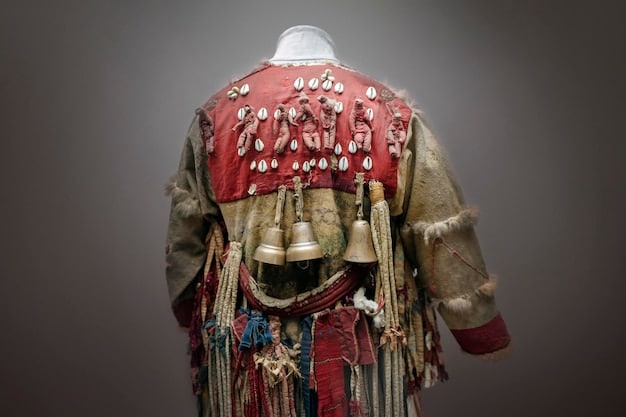
This exploration will delve into the key aspects that influence the historical accuracy, or lack thereof, in Chinese dramas.
The Creative License in Historical Dramas
Historical dramas, by their nature, often take liberties with historical accuracy. While rooted in actual events and periods, storytellers must craft compelling narratives, which sometimes means embellishing or altering details. This creative license is a double-edged sword, enhancing entertainment value while potentially distorting the historical record.
Understanding where and why these deviations occur is crucial for viewers seeking a balanced perspective.
Why Take Creative Liberties?
- Narrative Appeal: Dramatic effect, romance, and suspense often take precedence over strict historical adherence.
- Character Development: Characters might be composites or their actions altered to fit the story’s arc.
- Censorship: Content may be modified to comply with censorship regulations, particularly when dealing with sensitive political or social issues.
Examples of Creative Liberties
- Revised Timelines: Events may be compressed or reordered for narrative flow.
- Exaggerated Personalities: Historical figures can be depicted with amplified virtues or vices.
- Fictional Subplots: Entirely fabricated storylines or characters can be interwoven with historical events. For example, adding forbidden romances or dramatized political conspiracies.
Creative license in historical dramas is a common practice to enhance the narrative and appeal to a wider audience. This does not necessarily reduce the value of the drama as entertainment, but it is important that the audience understands it as a creative work, not a historical document.
Costume and Set Design: Aesthetics vs. Authenticity
The visual elements of Chinese historical dramas, including costumes and set designs, are often a major draw for audiences. The elaborate details, vibrant colors, and grand scale can create a mesmerizing viewing experience. However, the pursuit of aesthetic appeal can sometimes overshadow the commitment to historical accuracy.
Differentiating between what looks good and what is historically correct is a key aspect of critically evaluating Chinese historical dramas.
Common Costume Inaccuracies
- Anachronistic Styles: Mixing elements from different periods within a single dynasty or using styles from entirely different eras.
- Over-Embellishment: Adding excessive ornamentation, colors, and patterns that were not typical of the time.
- Fabric Choices: Using modern fabrics or dyes that were unavailable in the historical period.
Set Design Considerations
- Architectural Styles: Blurring the lines between different architectural styles from various eras in a single setting.
- Furniture and Props: Using furniture or props that are either anachronistic or not representative of the social class being depicted.
- Color Palettes: Employing color schemes that are visually appealing but not historically accurate based on available pigments and preferences.
While costume and set design in Chinese period dramas are visually stunning, they do not always accurately reflect the historical context. Understanding these discrepancies enhances the viewer’s ability to appreciate the artistry while remaining informed about the potential inaccuracies.
The Portrayal of Historical Figures: Fact, Fiction, and Propaganda
Chinese historical dramas frequently feature portrayals of famous historical figures, from emperors and empresses to generals and scholars. These portrayals can significantly shape public perception of these figures, making it crucial to examine the balance between historical fact, fictional interpretation, and even potential propaganda.
Analyzing how key figures are represented helps viewers distinguish between credible portrayals and those driven by narrative or political agendas.
Exaggerated Traits and Stereotypes
Historical figures are often presented with exaggerated traits to create more compelling narratives. For example, an emperor might be depicted as either a benevolent sage or a ruthless tyrant, simplifying their complex character for dramatic effect.
Revisionist Agendas
Some dramas may portray historical figures in a way that aligns with contemporary political or social agendas. This can involve downplaying or exaggerating certain aspects of their lives to promote specific ideologies or values.
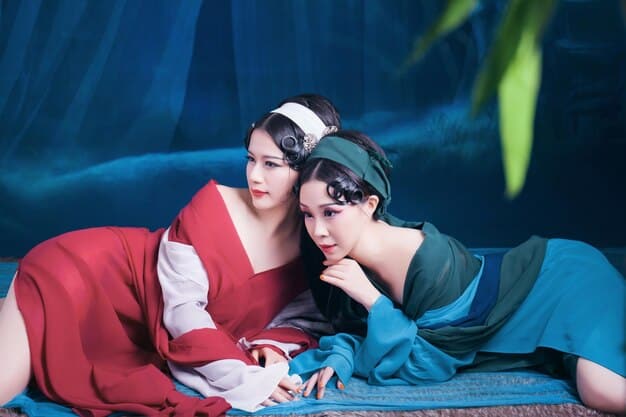
Language and Social Customs: Modern Sensibilities in Ancient Settings
One area where Chinese historical dramas often take considerable liberties is in the depiction of language and social customs. While these dramas aim to transport viewers to another time, they frequently do so through the lens of modern sensibilities, resulting in anachronisms and cultural inaccuracies.
Being aware of these discrepancies allows viewers to better appreciate the challenges of portraying ancient societies while also recognizing the potential for distortion.
Modern Language Usage
Characters in historical dramas often use language that is more akin to contemporary Chinese than the classical Chinese or vernacular dialects spoken during the depicted period. This is done to make the dialogue more accessible to modern audiences, but it can create a jarring effect for viewers familiar with historical linguistics.
Simplified Social Interactions
Complex social hierarchies, etiquette, and customs are often simplified or omitted altogether to streamline the narrative. This can lead to a misrepresentation of the intricate social dynamics that governed ancient Chinese society.
- Forms of Address: Simplified titles and honorifics may be used, failing to reflect the complex system of social ranking.
- Gender Roles: Traditional gender roles may be softened or subverted to align with modern values, potentially misrepresenting historical realities.
- Rituals and Ceremonies: Important rituals and ceremonies may be abbreviated or omitted, diminishing the understanding of their significance.
While modernizing language and social customs make historical dramas more accessible and relatable to contemporary audiences, they often come at the expense of historical accuracy. Recognizing these adaptations is crucial for viewers seeking a more nuanced understanding of the past.
The Impact of Censorship on Historical Accuracy
Censorship plays a significant role in shaping the content of Chinese historical dramas. Government regulations and guidelines often dictate what can and cannot be depicted, influencing the portrayal of historical events, figures, and social issues. This censorship can have a profound impact on the historical accuracy of these dramas.
Understanding the influence of censorship helps viewers critically assess the narratives presented and recognize potential biases or omissions.
Restrictions on Sensitive Topics
- Political Issues: Content that is deemed critical of the government or challenging to social stability is often censored. This can include depictions of rebellions, political infighting, or controversial policies.
- Historical Figures: Portrayals of historical figures may be subject to censorship if they are seen as promoting values or ideologies that contradict the official narrative.
- Social Issues: Sensitive social issues, such as corruption, inequality, or ethnic tensions, may be downplayed or avoided altogether.
Example
- Altered Narratives: Historical events may be reinterpreted to align with the official historical narrative.
- Omissions: Certain aspects of history may be omitted altogether to avoid controversy.
- Positive Spin: Negative events or figures may be portrayed in a more positive light to promote social harmony and national unity.
While censorship aims to maintain social order and promote specific values, it often comes at the expense of historical accuracy. Viewers should be aware of these limitations and seek diverse sources of information to gain a more comprehensive understanding of Chinese history.
Tips for Discerning Fact from Fiction in Chinese Dramas
Given the blend of historical fact and creative license in Chinese historical dramas, it can be challenging for viewers to discern the truth from fabrication. However, by adopting a critical approach and seeking out reliable sources of information, viewers can enhance their understanding and appreciation of these dramas while remaining informed about potential inaccuracies.
Here are some practical tips to help viewers separate fact from fiction:
Consulting Additional Resources
- Read History Books: Supplement your viewing experience with reputable history books and academic articles to gain a deeper understanding of the historical period and events depicted in the drama.
- Watch Documentaries: Seek out documentaries and historical programs that provide factual accounts of the events and figures portrayed in the drama.
- Consult Scholarly Articles: Search for scholarly articles and analyses that examine the historical accuracy of specific dramas and their portrayals of historical events.
Critical Viewing Habits
- Be Aware of Creative License: Recognize that historical dramas are works of fiction and that the creators often take liberties with historical accuracy to enhance the narrative.
- Cross-Reference Information: Compare the information presented in the drama with other sources to identify any discrepancies or inaccuracies.
- Consider the Source: Be mindful of the potential biases or agendas of the drama’s creators, production company, or sponsoring organizations.
| Key Point | Brief Description |
|---|---|
| 🎭 Creative License | Dramas alter details for narrative, character, and censorship reasons. |
| 👗 Costume & Sets | Visuals can prioritize aesthetics over historical accuracy. |
| 🗣️ Language | Modern language and simplified customs affect accuracy. |
| 🚫 Censorship | Censorship influences narratives and historical interpretations. |
Frequently Asked Questions
▼
Chinese historical dramas often blend true historical events with fictionalized elements for entertainment. Accuracy varies, so viewers should not consider them strict historical records.
▼
Creative license enhances narratives but alters details like timelines and character traits. Recognizing this helps viewers differentiate between fact and fiction.
▼
Costumes might mix styles from different periods or use modern materials for visual appeal, sacrificing historical accuracy for aesthetic purposes.
▼
Censorship can restrict sensitive topics, altering narratives to comply with government guidelines, which impacts the portrayal of historical events and figures.
▼
Viewers can supplement their viewing with history books, documentaries, and scholarly articles. Cross-referencing information helps identify inaccuracies and potential biases.
Conclusion
While Chinese historical dramas offer a captivating glimpse into China’s rich past, it’s essential to approach them with a discerning eye. By recognizing the creative liberties taken, the influence of censorship, and the potential for inaccuracies in costumes, sets, and portrayals of historical figures, viewers can better appreciate these dramas as works of entertainment while remaining informed about the complexities of Chinese history. Engaging with additional resources and cultivating critical viewing habits will further enhance the viewing experience, allowing for a more nuanced understanding of the past.
